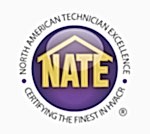HVAC systems are essential in keeping your family warm in Portland’s rainy, wet winters and cool in warm summers. To keep operating costs down, all of your HVAC components need to be running efficiently and this includes your home thermostat.
Homeowners often neglect their thermostats because they don’t realize how an old thermostat can affect energy bills. This guide will break down what a thermostat does and how a new thermostat can save you money.
How Do Thermostats Work?
Thermostats are a crucial component of your HVAC system. As the regulating brains of your HVAC system, a thermostat dictates how your heating and cooling systems run. The job of the thermostat is to constantly measure the air temperature in your home and direct your HVAC system to maintain a constant comfortable temperature no matter the weather outside.
How Older Thermostats Works
Many homes have either an analog/manual or programmable thermostat. Thermostats were a huge step forward for homeowners looking to lower their energy bill and regulate their home comfort level.
The first analog thermostats were born from a problem – how to regulate indoor temperatures without running to the basement furnace all the time. Great minds put themselves to the task and by the 1950s the popularity of wall-mounted thermostats was on a significant rise.
Analog Thermostats
Unlike thermometers, which just measure the temperature, analog thermostats use thermal expansion to regulate indoor temperature. Thermal expansion is the idea that most things get bigger when they heat up and smaller when they cool down.
Older thermostats use gas or pieces of bonded temperature-sensitive metal that expand and contract at different temperatures to create an electrical circuit that turns the HVAC system on or off.
When the room gets cool, the gas or metal contracts, creating a circuit that turns on the heat. As the room heats up the gas or metal expands eventually breaking the circuit and the heater switches off. How often this cycle happens depends on the temperature setting, the temperature outside, and how good your home insulation is.
Programmable Thermostats
A programmable thermostat works on the same basic technology as an analog but adds an extra energy saver – scheduling. Homeowners can program temperatures based on their schedule customizing temperatures and energy use.
A typical programmable thermostat has four settings: wake, leave, return, sleep. Some programmable thermostats allow homeowners to tailor each day to suit their needs and schedule while others allow for weekdays and weekend settings.
Drawbacks to Older Thermostats
While the technology of standard thermostats is simple, it is also slow to respond. It can take some time for the regulator to react to changes in temperature and eventually bimetal strips can wear out and no longer be accurate.
Additionally, with a manual thermostat, if you want to save money by not heating an empty house you will need to remember to adjust the thermostat every time you leave or return. Programmable thermostats only work when homeowners program them. And if your family has an irregular schedule it can be hard to keep your home at the right comfort level for everyone and still save money.
Average Lifespan of a Thermostat
Older thermostats typically last about ten years, but they can have a much longer lifespan depending on the make and model. Because, like your HVAC system thermostats age, it is a good idea to schedule a home thermostat replacement when you upgrade your HVAC system. By replacing your thermostat with your HVAC system you can make sure that your new thermostat is configured properly to your ideal temperature settings.
- The Best Temperature to Set Your Thermostat to in Summer
- The Best Temperature to Set Your Thermostat to in Winter
Signs that You Need to Replace Your Thermostat
The thermostat’s main role is to communicate to your HVAC system telling it to increase or decrease temperatures. There are a few telltale signs that it is time to replace your old thermostat:
- Your HVAC system keeps cycling on and off irregularly
- Registering wrong temperatures
- High energy bills
- Inconsistent temperatures through the house
- The thermostat won’t turn on or a blank screen (and it isn’t the batteries)
Smart Thermostats
Heating and cooling our homes is a significant part of our home energy costs and one of the most significant ways you can help reduce bills is with a smart thermostat.
What is a Smart Thermostat?
Home smart devices like modern thermostats offer a convenient way to control all aspects of your home’s comfort while also saving money. They do this in a variety of ways:
- predicting your schedule
- sensing when someone is home
- optimizing temperature based on local weather
- geofencing
A smart thermostat uses a compatible phone on your iOS device, Apple Watch and even Alexa or Siri for voice control over home comfort settings. This means that you can regulate your heating and cooling both at home and away.
Features of Smart Thermostats
There are quite a few smart thermostats on the market that offer different ways to customize your home but most share these features:
- connects to iPhone, computer, tablet, Alexa, Siri, or Google
- occupancy sensing to reduce energy use when no one is at home
- geofencing that knows when you are leaving or arriving
- creates reports of energy use
- connects with various energy devices like dehumidifiers
Benefits of a Smart Thermostat
The formula for how smart thermostats work is simple: when energy isn’t wasted you save money. This can translate into pretty significant yearly savings for many homeowners. Because smart thermostats allow you to cool and heat as much as you need, it could save you 10 to 12 percent on heating costs and 15 percent on cooling bills each year.
Are Smart Thermostats Worth it?
There are a lot of smart devices on the market and it can be difficult to determine which are essential and which are gimmicky. Since energy consumption in our homes is a significant part of homeowners’ monthly bills, saving money is a major plus. By making it easy and efficient to control your energy consumption, we think smart thermostats are worth the investment, offering effortless automated energy savings and paying for themselves in a few years.
Smart Thermostat Options
Gaining control over your home’s temperature is one of the highlights of a smart thermostat and Ecobee consistently tops the “best smart thermostat” lists. When installed correctly, an Ecobee smart thermostat can be connected to other smart-home devices and save up to 23 percent annually on your heating and cooling costs. Ecobee is also compatible with in-room sensors that can monitor multi-room temperatures. Get a professional to help you install a new thermostat to get your HVAC system and thermostat correctly configured together to maximize energy saving.
How Jacobs Can Help
Smart thermostats are a great long-term investment. Not only do they make heating and cooling your home much more convenient with pattern recognition and by enabling you to control them from anywhere, but they’ll also save you big time on annual heating and cooling costs. When it comes to any part of your heating system, you want a company that has the experience and knowledge to help you make informed decisions. Jacobs Heating & Air Conditioning experts are here to guide you.
If you’re interested in smart thermostat installation in your Portland, Oregon, or Vancouver, Washington home, contact Jacobs Heating and Air Conditioning to talk to a Home Automation specialist about our smart thermostat options.No matter what you need we’re always just a phone call away. You are welcome to review our statement on COVID-19 and how we’re taking precautions to protect you, our team, and our communities.










